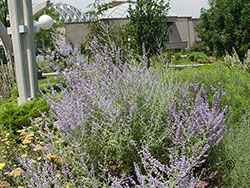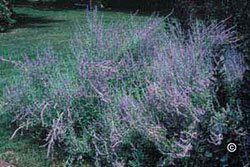 Russian sage, Perovskia atriplicifolia, is a plant that was tailor-made for Colorado’s climate and growing conditions. An import from central Asia, Russian sage thrives in our high, dry climate, bright sunshine and alkaline soils.
Russian sage, Perovskia atriplicifolia, is a plant that was tailor-made for Colorado’s climate and growing conditions. An import from central Asia, Russian sage thrives in our high, dry climate, bright sunshine and alkaline soils.
What does Russian Sage look like?
This sturdy plant is characterized by its upright and shrub-like shape, slender stems and finely-cut silvery-gray leaves, which are aromatic and resistant to the browsing of deer. Its square stems are an indicator that is it in the mint family. Though its common name includes the term sage, it is not in the genus Salvia the members of which are also commonly called “sages.”
Where should Russian Sage be planted?
 Russian sage is best planted where it will have room to grow to its mature size of three to five feet tall and three to four feet wide without being crowded. It needs full sun and well drained average soil for optimum growth.
Russian sage is best planted where it will have room to grow to its mature size of three to five feet tall and three to four feet wide without being crowded. It needs full sun and well drained average soil for optimum growth.
Is Russian Sage a sturdy plant?
Russian sage can be a focal feature in a Xeriscape garden. However it will also tolerate some heavier watering than what is often required in a Xeriscape. The soft, lavender-blue flowers appear in the late summer and remain attractive into the fall before going dormant in the winter. Great companion plants include purple coneflower, sunset hyssop, winecups, boltonia and black-eyed Susans.
The strong, upright shape of Russian sage provides a presence through the winter months, standing through wind and weather. As spring approaches, the stems should be cut back to almost to the ground to encourage new growth.



